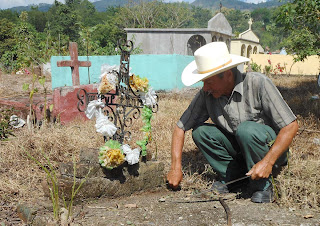 |
| My boss Merlin Fuentes demonstrates a miniature version of a fuel-efficient fogon at the Feria Ambiental |
And just to add to the over-stimulation, it's election day in Honduras today. People have already started streaming into local schools and other polling stations to participate in what is essentially the primaries for the 2013 election.
Rumour has it that things get interesting on days like today, when political opinions tend to heat up. Cuso Honduras actually told us volunteers to stay indoors today and stock up on emergency rations, advice that the locals got quite a kick out of when I told them. At any rate, my American friends are counting on me to lead them on a tour of the Mayan ruins and later the foster home where I help out, so shutting myself in the house isn't an option.
It's pretty amusing to be called into service as a Copan tour guide and a translator, neither of which I'm remotely qualified for. Happily, a genuine tour guide who's quite fluent in English has already attached himself to the group, wisely seeing an opportunity to be of service in all kinds of ways. But I suspect the group and I will still have a lot of hanging-out time in the week to come, and now the bonding experience of going through our first Honduran elections together.
Hosting missions from the U.S. and elsewhere is one of the goals of the Honduran non-profit I work for, the Comision de Accion Social Menonita (CASM). Faith-based groups from various denominations do a significant amount of project work in the country, coming down for a week or so to build schools, take on a water project, construct chicken coops or tackle whatever else needs doing.
This particular group is more eclectic than most, coming from four states and having family ties, old friendships and a parish preacher in common. So there's a mom-and-daughter pair, three siblings from another family, two parents with their two kids, a couple cousins. Some have done several missions before while others are trying it for the first time; one fellow is on his first-ever trip outside the U.S.
Starting at 8 a.m. tomorrow, they'll be spending five days in the countryside around Copan building about 40 wood cooking stoves in the homes of subsistence farmers. The group raised $2,000 to cover the costs of the stoves - fogones, as they're known here - and soon they'll be mixing cement and stacking bricks in homes in Guaramal, Mirasol and Libertad, three of the many, many struggling little villages around this region.
My organization has built about 350 stoves like these ones over the last three years. Everybody loves them. They burn 45 per cent less firewood, have chimneys to vent smoke out of the house, are insulated with ash so nobody gets burned, and have big cooking surfaces that can easily accommodate all those tortillas that are a constant of the Honduran diet.
But while the stoves cost a scant $40-$60 each to build, that's still a lot of money here. The only way farmers get the stoves is if CASM has development money from somewhere to do a project. Or if a good-hearted mission group from outside of the country raises money among their friends and heads on down to Honduras for a working holiday.
Pictures to follow. And now I'm off to the ruins, on a beautiful day in the midst of the drizzly season that I think must be some kind of karmic reward for good people who come all this way to make life a little easier for a few Honduran families.

.jpg)





